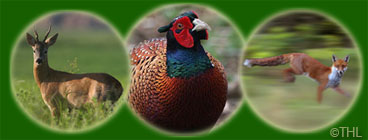Pigeon Shooting and Decoying Guide
Welcome to the hunting life pigeon shooting guide for newbies to the world of pigeon shooting and decoying.
| Month | Cereals & Feeding Habits |
|---|---|
| January | Oilseed rape - frosted potatoes - sugar beet tops. |
| February | Oilseed rape - unharvested brassicas - cover crops - maize |
| March | Oilseed rape - drilled spring cereals - drilled Peas |
| April | Late drillings - freshly chitted peas - young linseed |
| May | Spring rape - peas - new cover crops |
| June | Oilseed rape - pea vines - chickweed & setaside |
| July | Laid cereals - peas - Beans - set aside |
| August | Swathed rape - wheat + barley stubbles - pea Stubbles |
| September | Unploughed cereal stubbles - harvested beans |
| October | Autumn drillings - beech mast - acorns |
| November | Oilseed rape - beans - sugarbeet tops - setaside stubbles |
| December | Oilseed rape - potato fields |
Try to setup your hide so that the wind is on your back. This is because birds, like aircraft, need to land into the wind in order to slow themselves down. If you can’t find a place where you can setup with the wind on your back then a side wind is perfectly acceptable but make sure you place your decoys and rotary machine about 15 yards upwind.
This is so that the decoying pigeons come past your hide before reaching the pattern, giving you time to get off two shots. If you setup the decoys straight in front with a side wind then by the time you’ve fired the first shot the 2nd shot would be at a bird a long way downwind and going like a bat out of hell!
The majority of the time try to use the simplistic approach and use a traditional horseshoe style decoy pattern when using any of the decoy machines.

Rotary Patterns.
Place them about 15 yards out from the hide dead in front with a horse shoe pattern.
You must bear in mind that although the incoming birds pull very well to rotary machines when they get close (5-10 feet) to one they will flare because they realise that they’ve been tricked. Sometimes you will get the odd one which will land but if you are using a rotary for the first time be prepared for a new and exciting form of decoying.

One important thing is to set the speed of rotation right. On windy days with a 10-15 MPH wind you want a fast RPM i.e. max speed or there about and on less windy days 5-10 MPH you want it slightly slower about 75% on the speed controller dial. On totally windless days I prefer to leave the rotary in the truck and use my flappers, 20 flocked shell decoys and bouncers instead.

Flappers
The flapper is used to catch the eye of passing birds bringing attention to your decoy pattern and is used to increase confidence by simulating a bird landing safely amongst your decoys. They can also be used to guide in pigeons from a flight line to the area where you are decoying.
Another confidence boosting technique is to mount the flapper on a lofting pole in a sitty tree. These are all very good techniques for great sport particularly in winter shooting over rape when the birds are not easy to decoy. Depending on the scenario I use either one flapper on the ground and one on a bouncer or if the birds are hard to decoy then I mount both flappers on a bouncer.

Peckers.
I use pecking birds most often on drillings and stubbles but that doesn’t mean you can’t use them on any other crop at any other time of year! Normally I use two or three with an intermittent timer unit. I try and spread them about the pattern and find they work very well by adding a lot of movement to an otherwise static decoy pattern.
nmmn
Other things to bear in mind.
Although I have put these diagrams up here to help you get started please bear in mind that conditions vary daily and weekly and this will affect the pigeon’s activity and willingness to decoy tremendously. Always be prepared to try new things when out decoying and keep an open mind, and more importantly learn from your success or failures and try and analyse why.
Sometimes moving things around can make all the difference to your sport. Also bear in mind that you can have all the gadgets and gizmos in your pattern but they are no substitute for poor field craft!

